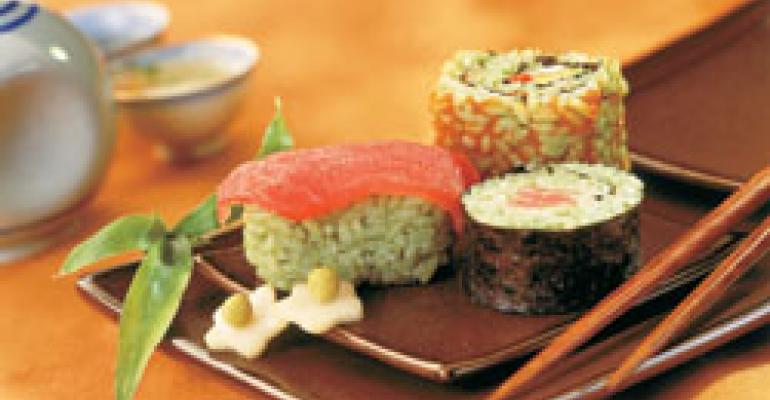Diners at the Doubletree Hotel Minneapolis Park Place are sometimes taken aback when they’re served sushi and the rice is green.
“My guests won’t eat it right away because they sometimes think it’s infused with wasabi,” says executive chef Chris Dwyer.
But many event planners love it, and customers have started to enjoy it, too.
Dwyer’s green rice is infused with chlorophyll from baby bamboo and imported from China. It tastes a little “woodsier” and nuttier than typical rice.
“It adds beautiful color and flavor to sushi and will make your ahi roll an instant bestseller,” Dwyer says. He cooks the rice normally and then leaves it covered for 20 minutes. He cuts in rice vinegar while bringing it to room temperature to shape into sushi rolls or to make nigiri sushi. “It will have a sticky quality like sushi rice, yet still maintain its texture and mild green-tea flavor,” he says.
A lot of chefs are coloring their rice green these days. Some, like Dwyer, buy it that way. Others are making traditional Mexican arroz verde, stirring in green-colored food after cooking it, or speckling it with green items like edamame and seaweed.
Others are using whole-grain rice, ranging from typical whole-grain brown rice to black and red rice. Still others are sticking to white rice but using specialty varietals.
Jean-Paul Labadie is adding green-colored food to his rice at Marche Bacchus in Las Vegas for the miso-marinated black cod dish he plans to add to the menu soon.
“It’s an expensive fish, so on the rest of the plate we have to go with something not so expensive,” says Labadie. “We can’t really use the most expensive potato, and the rice goes with the Asian motif. It allows customers to have a full plate without having to pay $50 for it.”
He cooks white rice and then folds in puréed green onion to it and lets it cool. At service he sautés mushrooms, red onion, squash, zucchini and carrots with garlic and shallot. He adds the rice and some chicken stock, heats it through and plates the bright green rice, speckled with other vegetables. The tan glazed cod goes on top along with a yellow-orange mustard-based sauce. He plans to charge around $34 for it.
But for his paella, Labadie uses a high-end Italian rice—Carnaroli. He says it’s “a little crunchier” than its famous cousin, Arborio rice. Carnaroli is also aged for a year, Labadie says, “so it’s got a little more flavor than Arborio, and it’s not much more expensive.”
He charges $37 for his paella, which is spiced with saffron and includes scallops, shrimp and mussels as well as chicken, chorizo, roasted bell peppers and asparagus.
“My grandparents are Spanish, and they’d probably kick me in the butt if they knew I was using Italian rice,” he says, but he notes that Carnaroli holds up well and stays firm, “even more so than Arborio.”
At Province in Chicago, chef-owner Randy Zweiban actually uses a Spanish rice variety traditionally used for paella, Calispara, in a dish that he equates to a Spanish risotto.
He cooks the rice risotto-style along with market squashes, bell and piquillo peppers, shallots, hedgehog mushrooms and herbs, finishing it with Manchego cheese and a roasted-garlic cream sauce.
Zweiban says he likes Calispara, which is not unlike Arborio, partly because all of its grains tend to be the same size and shape, allowing for extreme consistency in cooking. High-end rice in general tends to have that quality, he says.
At Prairie Grass Café in Northbrook, Ill., chef Sarah Stegner is cooking with black rice, which actually is part of the category of “brown” rices that still have their bran layer and germ intact.
“I like the texture of it,” Stegner says.
She adds the rice to sautéed onions and herbs and then gradually adds vegetable stock, keeping the rice just covered with liquid—similar to risotto, except that she doesn’t finish it with cream and cheese.
“It’s a pretty tight rice and takes awhile to absorb the liquid,” says Stegner, who cooks it for about an hour. She likes to serve it with something acidic, like a tomato coulis.
“I just think it brightens the flavor of the rice,” she says. “Gives it a little boost.”
Stegner likes to serve the rice with seasonal fish dishes that she normally offers as specials. A recent item like that—wild striped bass with black rice and roasted-tomato coulis, ran for $26.”
At Mercadito, a Mexican restaurant in New York, chef-owner Patricio Sandoval offers the central Mexican side dish arroz verde for $8.
“My mom used to make this for me at home,” Sandoval says. It’s one of the restaurant’s most popular side dishes.
“It’s more of a casserole,” Sandoval adds. He blends puréed poblano peppers, green peppers, epazote, cilantro, garlic and onion with chicken stock and adds that to sautéed, diced onion. He brings it all to a boil, adds rice and simmers it until cooked.
“Once that’s done, we put in a little heavy cream and Mexican cheese.” That’s put in serving dishes and placed under a broiler to brown the cheese.
At Sansei Seafood Restaurants & Sushi Bar, a chain in Hawaii, chef-owner D.K. Kodama blends cooked rice with sushi vinegar, shelled edamame, nametake mushrooms and wakame seaweed and serves that with a number of his dishes.
“This is a very local Hawaii dish,” he says. “It’s a delicious rice base for any fish dish served with a sauce.”

